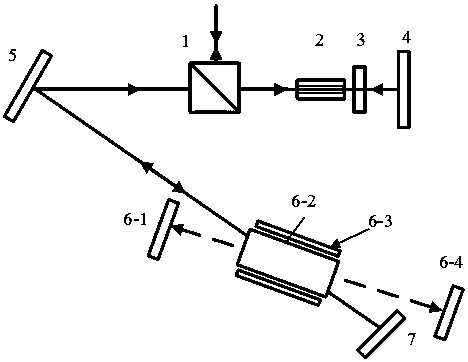Pulse stability control device and method of laser regeneration amplifier
A regenerative amplifier and stability control technology, which is applied in the laser field to solve the effects of poor pulse stability and low amplification efficiency
- Summary
- Abstract
- Description
- Claims
- Application Information
AI Technical Summary
Problems solved by technology
Method used
Image
Examples
specific Embodiment approach 1
[0024] Specific Embodiment 1: This embodiment provides a pulse stability control device for a laser regenerative amplifier, such as figure 1 As shown, the pulse stability control device is sequentially provided with a polarization beam splitter prism 1, an electro-optic Q-switching switch 2, a 1 / 4 wave plate 3, a first plane mirror 4, a second mirror 5, a laser amplifier and a gain Control module, the third reflector 7, wherein:
[0025] The polarization splitter prism 1, the electro-optical Q-switching switch 2, the 1 / 4 wave plate 3, the first plane mirror 4, the second mirror 5, the laser amplification and gain control module, and the third mirror 7 jointly form a laser regenerative amplifier;
[0026] The first flat mirror 4, the second reflector 5 and the third reflector 7 constitute the resonant cavity of the laser regenerative amplifier;
[0027] The laser amplification and gain control module is composed of a fourth reflector 6-1, a laser crystal 6-2, an LD target bar ...
specific Embodiment approach 2
[0041] Embodiment 2: This embodiment provides a method for controlling the pulse stability of the laser regenerative amplifier using the device described in Embodiment 1. The method is implemented by the following steps:
[0042] Step 1: The S-polarized pulse train laser is incident into the laser regenerative amplifier through the polarization beam splitter prism 1. When there is no external voltage applied to the electro-optic Q-switch switch 2, the pulse train laser passes through the electro-optic Q-switch switch 2, 1 / 4 wave plate 3 and The first flat mirror 4, the laser optical polarization state is changed to P polarized light, and the pulse train laser is transmitted through the polarization beam splitter prism 1;
[0043] Step 2: Apply a 1 / 4 wave voltage to the electro-optic Q-switching switch 2. When the laser passes through the electro-optic Q-switching switch 2 and the 1 / 4 wave plate 3 again, the polarization state will not change, and the P-polarized pulse train las...
PUM
 Login to View More
Login to View More Abstract
Description
Claims
Application Information
 Login to View More
Login to View More - R&D
- Intellectual Property
- Life Sciences
- Materials
- Tech Scout
- Unparalleled Data Quality
- Higher Quality Content
- 60% Fewer Hallucinations
Browse by: Latest US Patents, China's latest patents, Technical Efficacy Thesaurus, Application Domain, Technology Topic, Popular Technical Reports.
© 2025 PatSnap. All rights reserved.Legal|Privacy policy|Modern Slavery Act Transparency Statement|Sitemap|About US| Contact US: help@patsnap.com

